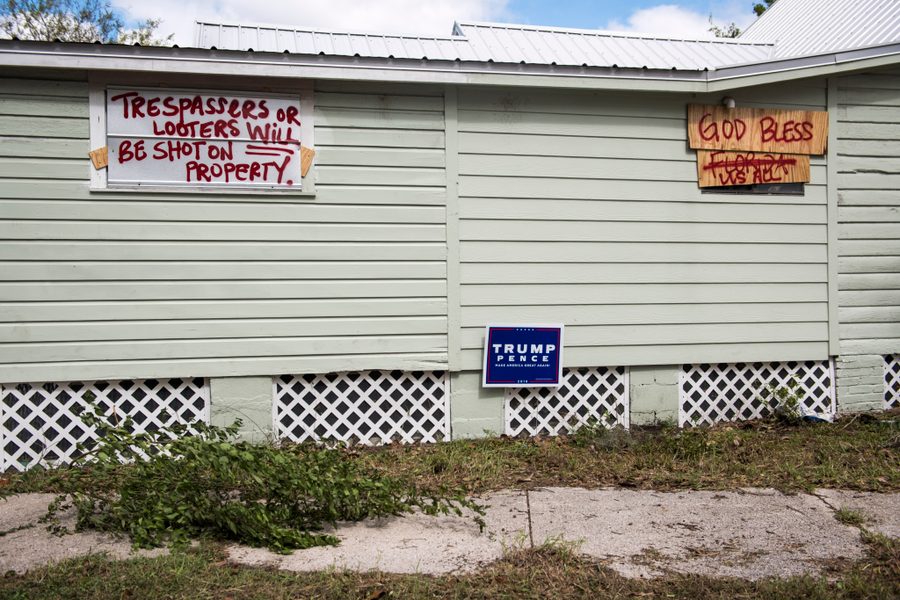The Confederacy Won't Die Until Florida Does
Election year in the epicenter of lost causes.
Hamilton Nolan

On Labor Day, a plane towed a big blue TRUMP 2020 banner over Crescent Beach, the wide, perfect beach just south of St. Augustine that draws visitors from all over Northeast Florida. It felt rude. That’s the point.
It also felt unnecessary. There was no one on that beach left to be swayed. The real beach people, who live in the tiny beach houses strung along Florida’s barrier islands, and walk down to the beach every day with nothing more than a surfboard, are not there to think about politics. They’re there for the beach. The majority of the Labor Day visitors, who line Crescent Beach from horizon to horizon with pickup trucks loaded with tents and coolers and generators and all of the detritus that wiser souls leave behind when they go to the beach, are already firmly in the Trump camp. Many have their own Trump flags affixed to their trucks, and need no encouragement from planes overhead. Their willingness to drag the concerns of the outside world onto the beach extends to politics.
Florida is defined by its coastline. Beach people spend much of their lives facing outward, gazing at the wide, lapping sea, with their backs to the roads and cities and humanity. It instills an expansive and philosophical mood. Those who fully embrace the beach think mostly of the weather, and the waves, and the fish and the birds. The tawdry ups and downs of the daily news cycle seem fleeting and insignificant compared to the entire ocean. Presidents and nations and cities will rise and fall, but the ocean will still be here. It will, in time, swallow us all. So enjoy it while it lasts.
It is not the unflappable perspective of the true beach people that lends Florida its reputation for insanity. The state’s interior is a sweltering, buggy patchwork of small country towns anchored by Walt Disney World, the black hole of the Florida universe, which pulls tourists towards it, filtering and squeezing them for money as they approach like a blue whale sucking in krill. South Florida is the trash can of America’s upper middle class, attracting that part of the nation’s population that is both rich enough to make life decisions based upon minimizing income tax rates, and vacuous enough to believe that an aggressively air conditioned model home on a golf course in a housing development built on what was recently a swamp is the ideal embodiment of the American dream. North Florida is indistinguishable from Georgia or Alabama or Mississippi, a deep South bastion with better beaches attached. In this huge and disconnected state, many tribes — rich Yankee golfers, surf bums, tourist-fleecing business moguls, immigrant farmworkers, stone cold rednecks, and millions of poor people whose best prospects are a job dressing up as Goofy at the Magic Kingdom — coexist without mingling.
Pundits seeking easy political narratives in Florida will always fail, because there is no coherent defining thread that unites all of these factions. (Not even the beach itself — a shocking number of Floridians refuse to ever venture outside of a space that is air conditioned down to “New Jersey in October” temperatures.) The one value that comes closest to doing so is racism, which accounts for its wonderful utility as a political tool. For someone like Donald Trump, who doesn’t care to dig too deeply into the intricacies of any situation, racism will do. As Confederate flags slowly become less socially acceptable, Trump banners have taken their place. They communicate the same sentiments. In Florida I have seen several trucks flying both of those flags at once, as if making explicit the bridge from one to the other. No one here misunderstands the point.
St. Augustine, where I grew up, is “the nation’s oldest city,” claimed for the Spanish by the explorer Pedro Menendez in 1565. He celebrated his discovery by massacring hundreds of French people at an inlet called Matanzas, now a popular local surf spot. A century later the Spanish built a big fort, the Castillo de San Marcos, which traded hands between colonial powers in various wars over the next several hundred years. The fort served as a prison for the famous Seminole leader Osceola, and today serves as the anchor of downtown St. Augustine’s many tourist attractions. Across the street from the fort, on the bayfront, Martin Luther King Jr. was arrested in June of 1964, while trying to integrate a local motel, the Monson Motor Lodge. (There is a famous photo of the motel’s owner pouring acid into its swimming pool in response to an integrated group of protesters jumping in.) A house that King was renting near Crescent Beach was riddled with bullets during his time here. When civil rights leaders tried to march into the plaza downtown, they were beaten unconscious by white mobs. King called St. Augustine “the most violent and lawless racial situation in the South.”

One week ago, the city of St. Augustine finally removed the Confederate monument that has sat in that downtown plaza since 1879. The Oldest City has not been dragged into the 21st century easily. When the city commission met in July to vote on removing the monument, citizens turned up to inform the commissioners who voted for removal that they would be booed wherever they appeared in public: “This is gonna be your new life from now on,” one speaker threatened. “I’m retired. I can be down here 24 hours a day, seven days a week. And I will.”
“I don’t think you understand the repercussions that are gonna come to you,” said another, a woman from a prominent local family. “It’s not just gonna be your jobs on the line.” Another, a young man wearing a bandanna and cowboy hat, declared, “Violence. Is on. The table. Thank you.”
Still, the penis-shaped monument, around which generations of juvenile delinquents had lounged around drinking in public after dark, was dug up, packed onto a barge, and moved down the river to a fish camp outside of town, where it will now sit in more comforting surroundings. Many Confederate flag-waving locals criticized the $236,000 that the city spent to move the monument, and rightly so. It could have been dumped directly into the river for a much lower cost. That’s what we get for trying to preserve these things.
The Confederates lost more than 150 years ago, but the South is still not rid of them. The symbols may change, but the mindstate carries on through the generations. Poor white people have always been the boogie men of Southern racism, but it is the golf course types, the boats-and-Benzes crowd, that you really need to watch out for. The violent racism that Martin Luther King Jr. found in St. Augustine became the sneering Rush Limbaugh-style racism of my youth, which became the wheedling, slick-haired Ron DeSantis racism of today. There are Trump signs by the new candy factory by the local hospital, and by the shabby strip mall with the Thrift Store and the World Gym; there are Trump signs on expensive houses downtown, and on the suburban lawns, and on the clean new houses that have sprouted along stately Magnolia Avenue, just by the entrance to the Fountain of Youth, where my friends and I used to sneak in as kids to gulp the municipal water that is repackaged as Ponce de Leon’s magical elixir; there is a giant “Q” flag along A1A, not far from the St. Augustine lighthouse, and an even bigger banner reading “TRUMP 2020 — MAKE LIBERALS CRY AGAIN” hung from a bayfront house close to where the Monson Motor Lodge used to be. The old men of St. Johns County who joined the Klan and beat civil rights marchers in the 1960s had kids who became local Republican businessmen, and grandkids who now affix Trump flags to large poles on the back of their Ford F-150s that flap sharply while they drive to Home Depot, listening to hip hop on a Jacksonville radio station. Lincolnville, the historic Black neighborhood close to downtown St. Augustine that served as the starting point of King’s civil rights marches, has now been largely gentrified, and if you drive its streets you will even find Trump signs there — but only on the nicest and newest houses.
Every one of these Trump signs is a malevolent little blister rising up from the skin of the nice small town where I was raised, and a reminder of what made me leave. The beating sun has bestowed Florida with everything it has, but it has also made it always and forever a hot, hard place. It is often observed, when you get out into the little country towns where sheriff’s deputies reign supreme and Black neighborhoods are sometimes full of shacks, that not much has changed around here since 1860. That is true, but it doesn’t quite capture what sets Florida apart from the rest of the South. Here — when you brush away the golf courses and the McMansions and the tourist traps, all of which will be reclaimed by nature soon enough — not much has changed since 1565, when Pedro Menendez celebrated the founding of my hometown by chopping up the French soldiers who had arrived before him, in the name of the king and the church. Florida is and has always been a place beset by invaders. Invasive conquistadors; invasive species; invasive developers; invasive politicians; all seeking to squeeze the state like an orange, to drink its juice and move on.
Donald Trump won Florida by a single point in 2016. He needs to win it again, or his chances for reelection are dim. Everyone knows it will be close. That’s all there is to know. It is tempting, always tempting, to judge that Florida is poised at an exciting turning point — a vibrant and diverse state, forever on the edge of turning blue. But it is a mistake to get too hopeful about this place. The gators bite and the mosquitoes swarm, and everything is destined to blow away in a hurricane. This is not a friendly place, no matter what Mickey Mouse would have you believe. There’s a gun in every glove compartment. We’re not supposed to be here. The Confederacy will last forever in Florida, because Florida itself is a testament to belief in a lost cause. The lure of the beach is that if you stand there, facing out towards the water, you can forget about everything else that is happening in the state located behind you. And when it all begins to crumble at last, you can walk ahead, and swim away.
Hamilton Nolan is a labor writer for In These Times. He has spent the past decade writing about labor and politics for Gawker, Splinter, The Guardian, and elsewhere. More of his work is on Substack.








